Taking the William Kennett Archive to the tip of Queensland
By Anna Thurgood, Engagement Officer, State Library of Queensland. | 29 May 2023
This blog article contains Aboriginal and/or Torres Strait Islander content, which has been made available in accordance with State Library of Queensland’s Aboriginal and Torres Strait Islander Collections Commitments. This material may also contain images or names of deceased persons.
William Kennett was a young teacher working in London when he applied for the position of Industrial School Master with the Society for the Propagation of the Gospel in Foreign Parts (SPG), in 1866. The purpose of the job was to help form a Christian mission, with a school, at the tip of Cape York under the supervision of The Reverend Frederick Charles Jagg.
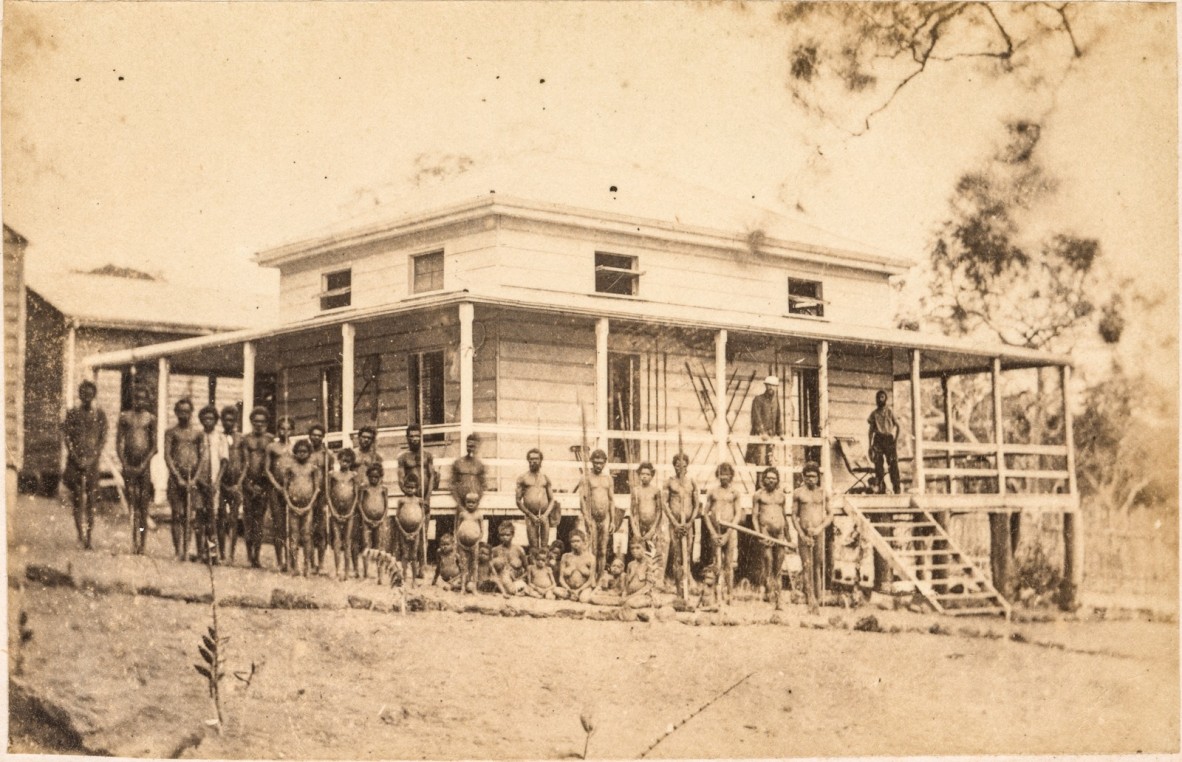
Customs House, Somerset, 1867-1869. William Kennett. Image no. 33001-0028-0001. John Oxley Library, State Library of Queensland.
The collection Kennett amassed during his sojourn on Cape York covers the period 1866-1869, and intersects with an important period of Queensland’s history. Queensland had just become a self-governing colony by Queen Victoria's proclamation in 1859 and its first governor, George Bowen, personally selected the site of Somerset in 1862 as the main provisioning port on the preferred route for ships travelling to and from England. However, it was not fit for purpose and support was withdrawn in 1868. Thursday Island was eventually selected as a much more suitable site.
William Kennett wrote about the Governor's intentions for Somerset in one of his long 'journal letters' he sent home:
This settlement was formed in August 1864 partly as a harbour of refuge for shipwrecked crews but chiefly to form the nucleus of a town, which as Sir George Bowen writes “should rival Singapore”.
(Left and right) Francis (Frank) Lascelles Jardine, Somerset, 1867-1869. William Kennett. (Left) image no. 33001-0058-0001 and (right) image no. 33001-0059-0001. John Oxley Library, State Library of Queensland.
John Jardine, appointed as the area’s first Police Magistrate, did indeed arrive in 1864 with a small contingent of marines who set about constructing buildings for the settlement. Two of Jardine’s sons, Frank and Alex, arrived the following year having driven 500 head of cattle from Rockhampton to establish a station. So by the time Kennett and Jagg arrived in 1867, the local Aboriginal and Torres Strait Islander people had only been in sustained contact with Europeans for two years.
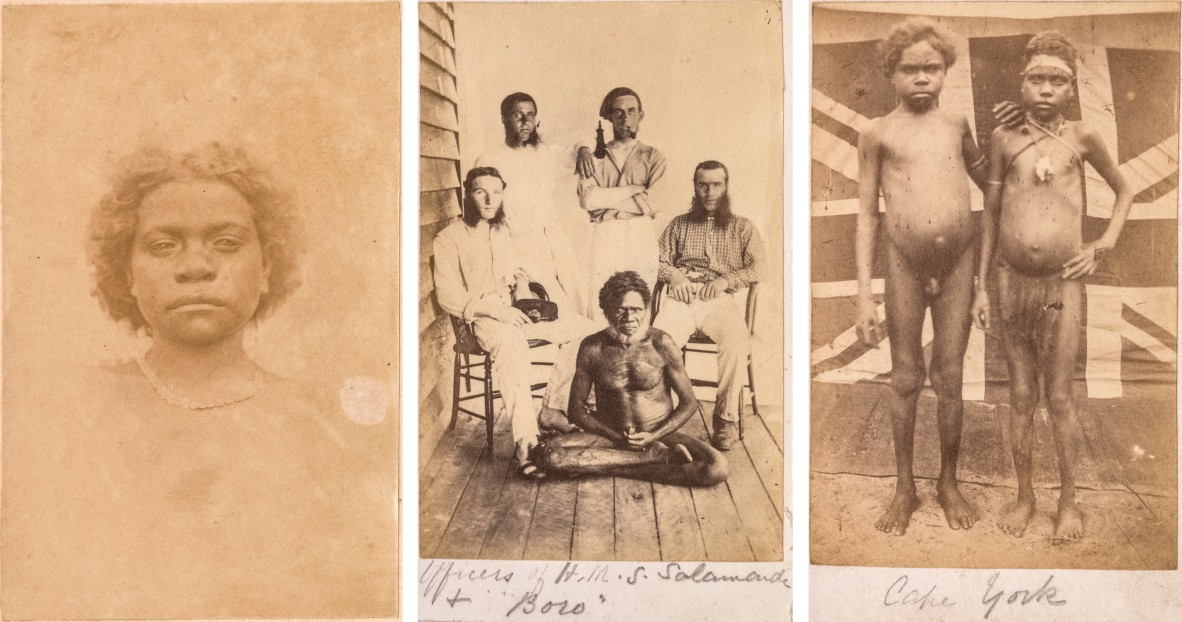
(Left) Gudang woman, Somerset, 1867-1869; (centre) Officers of H.M.S. Salamander with Boroto, Somerset, 1867-1869; (right) Young boy and girl, Korkeraga tribe, Cape York, 1867-1869. All photographs by William Kennett. Image numbers: (left) 33001-0085-0001; (centre) 33001-0076-0001; (right) 33001-0096-0001. John Oxley Library, State Library of Queensland.
One extraordinary feature of this collection are the photographs, including many portraits of local First Nations people as well as the European settlers and buildings at Somerset. Although a teacher, Kennett also happened to be a professional photographer and was running his own studio in London at a time when photography was a brand-new technology. The fact that he brought his own equipment with him, effectively operating an outdoor studio in Somerset, adds incredible significance to his archive. He was, in effect, creating a primary documentary source about the beginning of European settlement and the aftermath of 'first contact' at the far northern tip of Queensland.
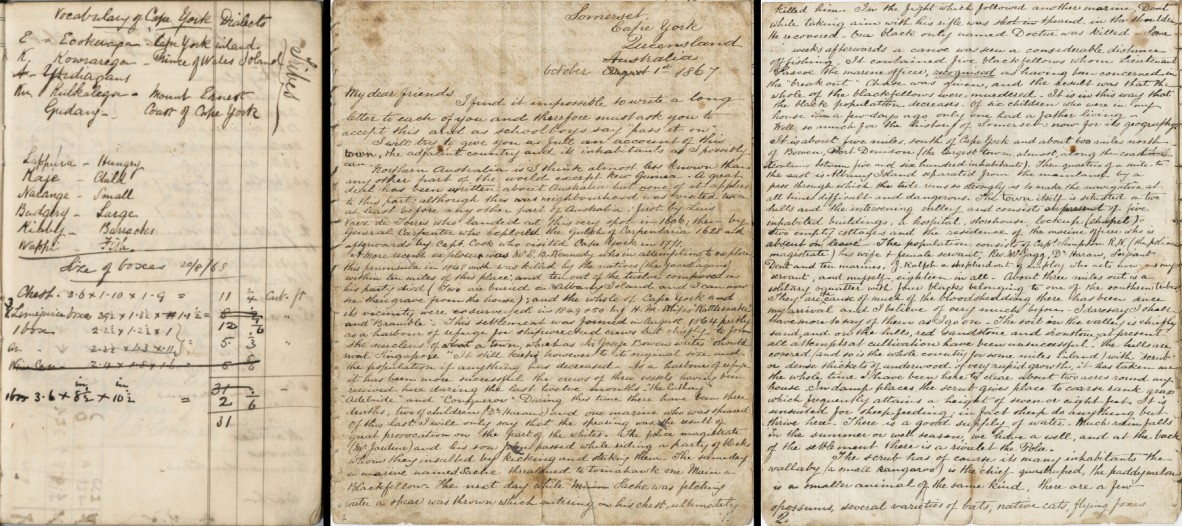
(Left) Page from William Kennett's diary, with local language words, Somerset, 1866-1869; (centre and right) Pages 1 and 2 of William Kennett's journal letters covering period 14 March - 31 August 1867. Item numbers: (left) 33001-0001-0021; (centre) 33001-0002-0001; (right) 33001-0002-0002. John Oxley Library, State Library of Queensland.
The photographs are accompanied by a diary and two long-form letters which Kennett refers to as ‘journals’. Kennett was curious about and interested in the Aboriginal and Torres Strait Islander people he encountered during his stay, and their culture. In these written accounts, he records local language and brief genealogies along with the names of Aboriginal and Torres Strait Islander children attending the school. He was a keen collector and writes about bartering for artefacts which were later sold to the British Museum, and many of which have been digitised and are available in their online catalogue.
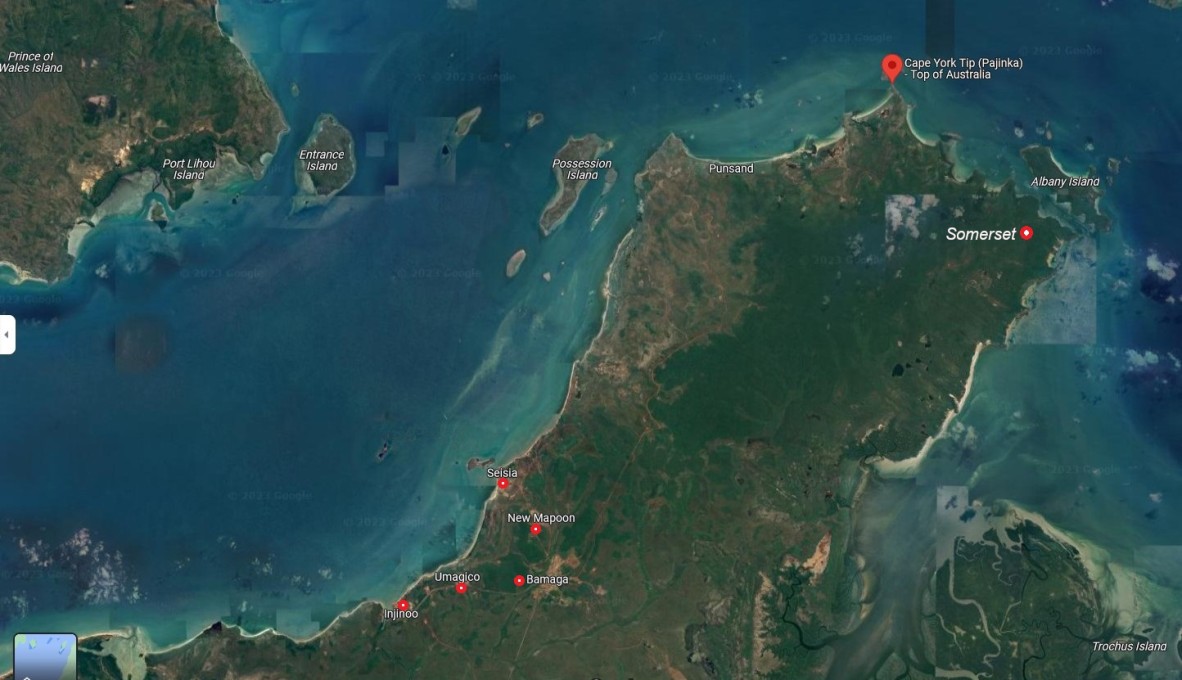
Far northern tip of Cape York, Queensland, showing towns of Northern Peninsula Area and site of Somerset settlement, retrieved 30 March 2023. Image courtesy Google Maps.
Following this acquisition, State Library decided the collection presented an ideal opportunity to engage with the First Nations communities who feature so strongly throughout the Archive. The Northern Peninsula Area is a local government area covering the tip of Cape York Peninsula, including the five closely situated towns of Seisia, New Mapoon, Bamaga, Umagico and Injinoo as well as the historical location of Somerset on the eastern side of the tip. State Library felt it was important to share the collection with Traditional Owners, to talk about and listen to their stories, and incorporate any knowledge or information in our records.
Through our connections with the Indigenous Knowledge Centres (IKCs) network and our colleagues in Cairns, we discovered the best time to visit the NPA would be during the Cultural Festival in late June 2022, when a large number of locals and tourists come together to celebrate the unique Aboriginal and Torres Strait Islander culture of far northern Cape York.
(Left) NPA Cultural Festival sign, Bamaga airport; (right) Torch relay arriving at Cultural Festival on Day 1, June 2022. Images supplied.
Pauline Lifu, Coordinator at New Mapoon IKC and a Traditional Owner of the area, was instrumental in organising a meeting between Queensland Memory staff and the Traditional Owners to discuss what the Kennett Archive may mean to the local community and to learn as much as we could about the collection.
(Left) ant hills on the side of the road between Bamaga and Umagico; (right) Seisia wharf at sunset, June 2022. Images supplied.
State Library staff prepared some resources, including a number of large reproductions from the Kennett Archive and booklets showing the collection in its entirety, and everything we needed to display images from the collection. It took all day to fly from Brisbane to Bamaga and we had an hour before sunset to explore some of the local sights before retiring to our accommodation. The entire area was booked out for the Festival and we were lucky to secure two rooms at a small accommodation centre run by Council, shared with a group of fly-in/fly-out vets from Cooktown.
The following day, we sat and spoke with Traditional Owners for some hours. They were extremely generous with their time, knowledge and stories, and we learnt a lot, not just about the collection and its content, but also about the area and its history. They recognised familiar names and faces, cultural items and a traditional boat in the photographs, and already knew of William Kennett.
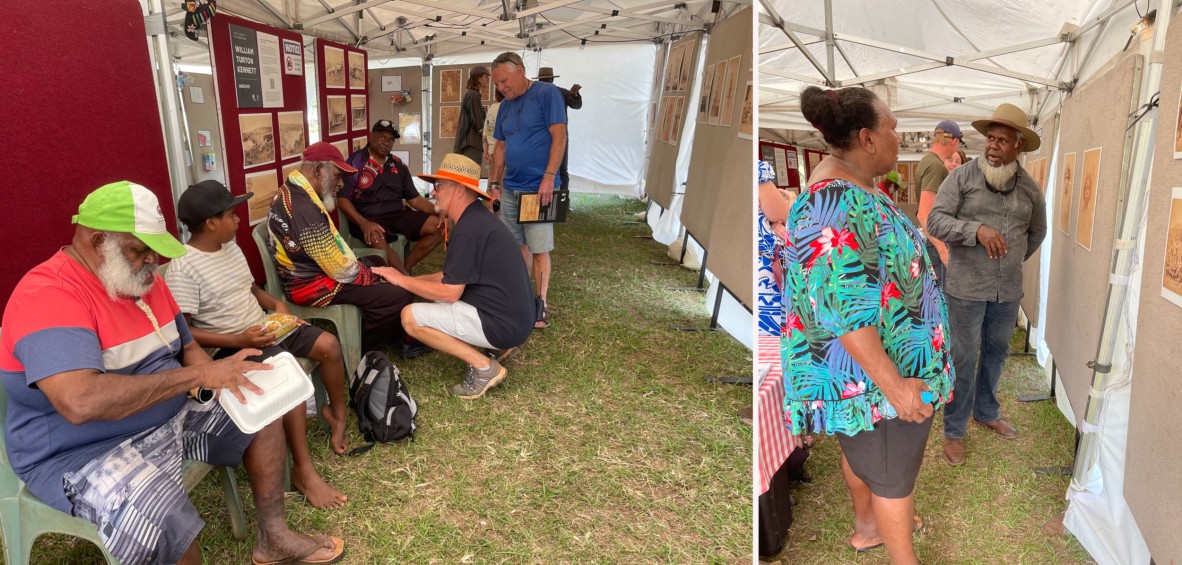
(Left and right) Traditional Owners from NPA supervise the William Kennett display and talk with visitors at the Cultural Festival, June 2022. Images supplied.
Traditional Owners gave us their blessing to display the reproductions of Kennett’s photographs and talk to visitors about his manuscripts at the Cultural Festival. Irrepressible festival organiser Dev Lengiel gave us a generous display space which we shared with the local primary school students’ artworks. My colleague and I installed the images, despite the strong winds almost blowing us away, and hoped people would be interested.

(Left) Food stall at NPA Cultural Festival selling traditional and contemporary food; (right) Naygayiw Gigi Dancers kick off the Cultural Performances at the Festival, June 2022. Images supplied.
Over the two days of the festival we had literally hundreds of conversations with both locals and tourists about this significant archive. Some returned again and again and others spent hours poring over Kennett’s diaries and journals. The Traditional Owners supported and assisted us, being a reassuring presence in the tent throughout the festival. It was wonderful to watch them share their stories and their history with people from every walk of life imaginable. Everyone was amazed to see State Library of Queensland staff in Bamaga sharing their collections and we immersed ourselves in cultural elements of the festival eating local food and watching the incredible dance groups in the evening.
(Left) London Missionary Society memorial, Somerset; (right) Traditional Owners Uncle Tommy Savage and Michael Solomon (at left) talk to visitors to Somerset on the site of the Jardine family homestead, June 2022. Images supplied.
Despite our exhaustion after the festival, the next day was to be the most memorable of all. We were due to fly out late in the afternoon and were just starting to think about what to do with our day, when we were surprised by Traditional Owner and Gudang/Yadhaykenu elder Uncle Tommy Savage, who arrived to pick us up at our accommodation at 9am with the intention of driving us out to visit Somerset, or what remains of it. We picked up fellow Traditional Owner Michael Solomon and drove the 40+kms to the site of Somerset. They showed us remains of buildings and constructions, such as a stone wall built for Frank Jardine and his wife Sana. Tommy and Michael spoke to tourists who were thrilled to hear from Traditional Owners at this historic place, where there is no signage or information of any sort.
(Left) Reuben Hillier at the site of Frank and Sana Jardine memorials, Somerset; (right) On the road to Pajinka and the tip of Cape York, June 2022. Images supplied.
We went down to the beach where we were shown the graves of Frank Jardine and his wife Sana, a Samoan woman of royal descent, and others, then drove a short way to view the disused airstrip. Tommy and Michael then drove us up to Pajinka – the very tip of Cape York and most northern point of Australia. We walked the rough track to the point and back, then sped back to Bamaga to retrieve our luggage just in time to fly out. It was an incredible day that neither of us will ever forget.
Apart from establishing a lasting relationship with the local community in the Northern Peninsula Area, this trip offered a platform for First Nations people to share their perspectives about a historically significant collection with State Library of Queensland and the wider community. State Library is committed to incorporating the knowledge and information shared so generously with us into the catalogue records for the William Kennett Archive. We are also very hopeful of working with Traditional Owners to record their stories in the form of oral histories, a project we aim to undertake in the near future.
Comments
Your email address will not be published.
We welcome relevant, respectful comments.